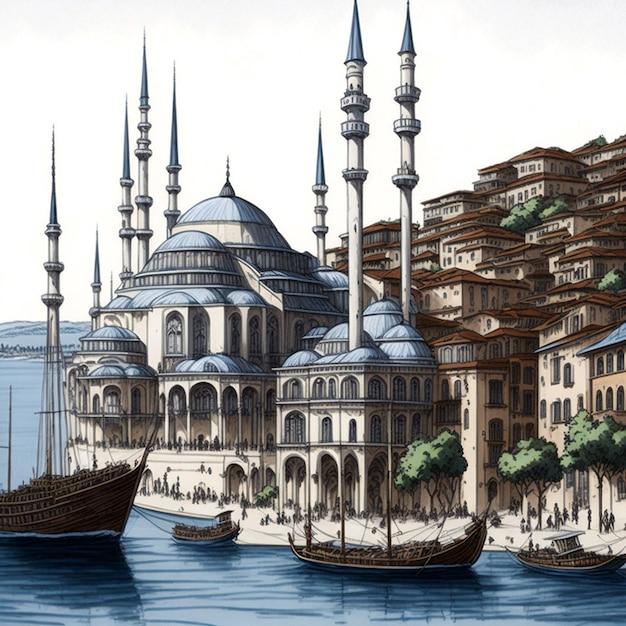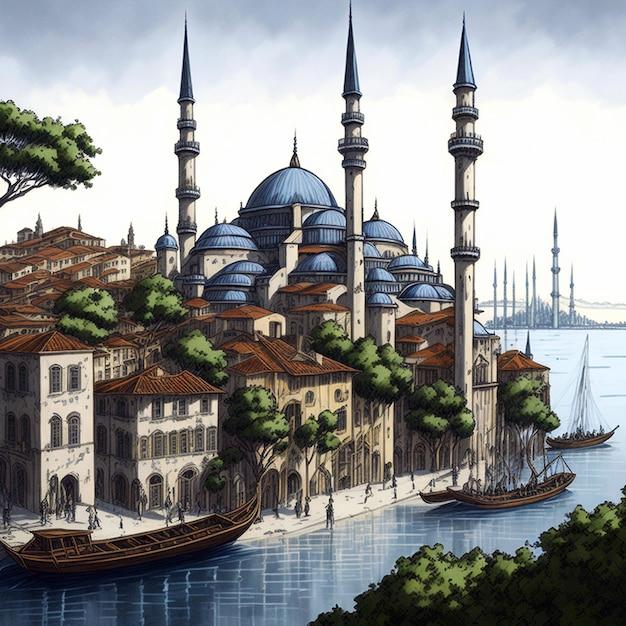Constantinople, the illustrious city situated at the crossroads of Europe and Asia, captivated the world with its beauty, splendor, and power. Once an ancient Greek city known as Byzantium, it transformed into the heart of the Byzantine Empire. Having withstood the test of time and numerous conflicts, Constantinople served as the center of Byzantine strength, culture, and influence for over a millennium.
But how did this remarkable city rise to such prominence? What drove its growth and transformation? In this blog post, we will delve into the captivating story of how Constantinople emerged as the glorious hub of the Byzantine Empire. Along the way, we will explore the city’s contributions, the pivotal figures who shaped its destiny, and the defining moments that made it an enduring symbol of civilization. So, let’s embark on this journey to discover the fascinating history of Constantinople and its integral role in the Byzantine Empire’s grand narrative.
How Constantinople Became the Enchanting Hub of the Byzantine Empire
Constantinople: A Love Affair That Spawned Empirical Powerhouses
The story of how Constantinople became the bustling hub of the Byzantine Empire is one of love, ambition, and strategic location. Situated at the crossroads of Europe and Asia, this enchanting city captivated the hearts of emperors and empresses throughout the ages, cementing its destiny as a center of power and influence. Join us as we dive into the captivating tale of how Constantinople rose to prominence in the annals of history.
The Strategic Geographical Advantage
Nestled on the eastern edge of Europe, Constantinople harnessed a strategic geographical advantage that made it an irresistible prize for empires hungry for dominance. Positioned between the Black Sea and the Mediterranean, with easy access to lucrative trade routes, this city nestled on the Bosporus Strait became a beacon for ambitious rulers seeking to control both land and sea. Its location provided a natural fortress, making it an impregnable stronghold against invaders and a gateway to vast wealth.
The Visionary Emperor Constantine
In the early 4th century, Emperor Constantine had a vision that left an indelible mark on the destiny of Constantinople. He saw the potential for a new capital, a city that would bear his name and become the beating heart of the Byzantine Empire. This bold vision led to the foundation of Constantinople in 330 AD. Constantine’s keen eye recognized the unparalleled potential of this location, foreseeing its rise as the epitome of imperial grandeur and power.
Awe-Inspiring Architecture: A Testament to Glory
One cannot speak of Constantinople without marveling at its awe-inspiring architecture. The cityscape was adorned with magnificent structures that showcased the wealth and power of the Byzantine Empire. From the iconic Hagia Sophia, which still stands as a testament to human ingenuity, to the majestic Hippodrome that hosted thrilling chariot races, Constantinople’s architectural marvels commanded the admiration of both locals and visitors alike. These structures not only showcased the artistic prowess of the empire but also added to the captivating allure that drew people from far and wide.
Trade, Wealth, and Luxury
Constantinople’s rise to prominence was inseparable from its flourishing trade routes and the lavish wealth they brought to the empire. The city became a bustling hub of commerce, connecting Eastern and Western worlds through its thriving marketplaces. Rare goods from distant lands adorned its shops, tantalizing even the most discerning patrons. As luxury flowed through its marble streets like a river, Constantinople became a symbol of opulence and extravagance, attracting not only traders but also scholars, artists, and seekers of fortune.
Strong Walls: Shielding Greatness from the World
One cannot discuss Constantinople’s glory without acknowledging its formidable walls. The city was ringed with towering fortifications that stood as a steadfast shield against countless invaders. From the Theodosian Walls, a testament to the perseverance of Emperor Theodosius II, to the Sea Walls that protected the city’s maritime borders, Constantinople’s defenses were a force to be reckoned with. These impregnable walls not only preserved the empire’s stability but also added an air of invincibility that only intensified its allure.
Constantinople’s ascent to becoming the vibrant center of the Byzantine Empire was no accident. It was the result of an intricate dance between geography, ambition, and architectural magnificence. From its strategic location to the visionary leadership of emperors like Constantine, the city’s captivating allure and tangible wealth captured the world’s imagination. As Constantinople flourished, its lavishness, trade, and strong defenses established an empire that would etch its name into the annals of history.
FAQ: How Constantinople Became the Envy of the Byzantine Empire
Welcome to our comprehensive FAQ-style guide on the fascinating history of how Constantinople rose to glory as the center of the Byzantine Empire. Prepare to delve into the intriguing world of ancient civilizations, legendary rulers, and a city that would capture the hearts and minds of many for centuries to come. So, grab your virtual time travel device, and let’s embark on this exciting journey!
What Sport Was Considered the Rage in Constantinople
Ah, the Byzantines sure knew how to have some fun! In the bustling streets of Constantinople, the most popular sport of the time was chariot racing. Imagine the Formula 1 of the ancient world, and you’re on the right track! The locals — always passionate about their team of choice — would gather at the Hippodrome, a massive chariot racing arena, to cheer on their favorite racers. It was like a medieval Super Bowl, but with more dust and the occasional chariot collision!
What Were the Three Most Important Contributions of the Byzantines
The Byzantines were quite the overachievers, making numerous noteworthy contributions. However, if we had to narrow it down to the top three, they would be:
1. Preserving Classical Knowledge: While Europe was still stuck in the Dark Ages, the Byzantine Empire kept the torch of knowledge burning bright. They meticulously safeguarded the works of ancient Athenian scholars like Plato and Aristotle, ensuring that future generations would have access to these invaluable treasures.
2. Developing Christian Art and Architecture: The Byzantines put their artistic prowess on full display, crafting breathtaking mosaics, awe-inspiring frescoes, and ornate icons that incorporated their deep religious beliefs. Not to mention, they built some of the most magnificent churches and cathedrals the world has ever seen, leaving architectural marvels that still dazzle tourists today.
3. Codifying Roman Law: Emperor Justinian was truly the ruler of all rulers when it came to legal matters. He compiled and refined Roman laws into the famous Justinian Code, which laid the groundwork for modern legal systems. His efforts were revolutionary, bringing order and justice to the Byzantine Empire and influencing legal systems for centuries to come.
Who Devastated Constantinople in 1204 CE
Prepare to clutch your medieval pearls because this is a tale of treachery! In the year 1204 CE, during the Fourth Crusade, Constantinople fell victim to a bloody and tragic event. The Crusaders, who were supposed to be on a holy mission to reclaim Jerusalem, decided to take a little detour and stopped by Constantinople for some good old-fashioned looting and pillaging. They stormed the city like a troop of unruly teenagers raiding a snack bar, leaving a trail of destruction in their wake. The once-proud Constantinople was left in ruins, a shadow of its former glory.
How Did Constantinople Become the Glorious Center of the Byzantine Empire
Ah, the tale of Constantinople’s rise to power is as epic as the latest binge-worthy TV series. Picture this: It’s the year 324 CE, and Emperor Constantine has a dream. He envisions a mighty city that would serve as the capital of the Eastern Roman Empire, a crown jewel to rival Rome itself. Inspired by this vision, he carefully selects the perfect spot for his new capital and names it after himself, because hey, who doesn’t love a bit of self-promotion?
Constantinople’s prime location on the Bosporus Strait, connecting the Black Sea and the Mediterranean, made it a coveted hub for trade and commerce. It soon became the beating heart of the Byzantine Empire, pulsating with life, culture, and an unrivaled sense of grandeur.
Which Is the Most Majestic Feat of Justinian
Ah, Emperor Justinian, the original Emperor Extraordinaire! Among his many triumphant endeavors, his greatest achievement was undoubtedly the construction of the Hagia Sophia. This architectural marvel, completed in 537 CE, was more than just a church; it was a testament to human ingenuity and divine inspiration.
The Hagia Sophia defied gravity with its massive dome, adorned its walls with breathtaking mosaics, and left all who beheld it in awe. Many centuries later, it would become a symbol of the Byzantine Empire’s legacy, an architectural wonder that would inspire countless imitations and stand as a testament to the empire’s artistic and engineering prowess.
What Makes Theodora the Ultimate Empress
Oh, Theodora, you sassy and influential empress, you! Theodora is best known for her unwavering support of her husband, Emperor Justinian, and her empowerment of women in Byzantine society. She fearlessly challenged societal norms and fought for the rights of women, implementing laws to protect them from exploitation and championing their education.
But it wasn’t just her social activism that made Theodora unforgettable. She was a force to be reckoned with on the political stage, using her intelligence and wit to aid her husband in governing the empire. Theodora proved that behind every great man is an even greater woman, and she left a lasting legacy as a true icon of female empowerment.
And there you have it, fellow time travelers! Our FAQ-style guide has shed some light on the captivating story of Constantinople’s rise to prominence as the center of the Byzantine Empire. From chariot races to monumental architecture, the Byzantines truly left their mark on history. So, until our next adventure, remember to embrace the lessons of the past, because they shape the world we live in today. Safe travels, and keep exploring the fascinating tapestry of human history!
Follow us for more intriguing tales from history and unconventional travel tips. Together, let’s uncover the hidden gems of the past and make history come alive in the present!
Published on: March 15, 2023

